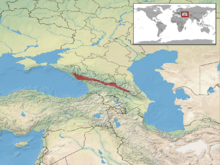Vipera dinniki
| Vipera dinniki | |
|---|---|
 | |
| Conservation status | |
| Scientific classification | |
| Kingdom: | Animalia |
| Phylum: | Chordata |
| Subphylum: | Vertebrata |
| Class: | Reptilia |
| Order: | Squamata |
| Suborder: | Serpentes |
| Family: | Viperidae |
| Subfamily: | Viperinae |
| Genus: | Vipera |
| Species: | V. dinniki |
| Binomial name | |
| Vipera dinniki Nikolsky, 1913 | |
 | |
| Synonyms | |
| |
- Common names: Dinnik's viper, Caucasus subalpine viper.[2]
Vipera dinniki is a venomous viper species endemic to Russia, Georgia, and Azerbaijan.[1] No subspecies are currently recognized.[3]
Etymology
The specific name, dinniki, is in honor of Russian herpetologist Nikolai Yakovlevich Dinnik.[4][5]
Description
Of the 49 Russian specimens examined by Orlov and Tuniyev (1990), 29 were males, and the largest male measured 41.2 cm (16.2 in) in total length (body + tail). Of the 20 females, the largest was 48.6 cm (19.1 in) in total length.[2]
Geographic range
V. dinniki is found from Russia (Great Caucasus) and Georgia (high mountain basin of the Inguri River), eastward to Azerbaijan.
According to Nikolsky (1916), the type locality is "upper reaches of the Malaya Laba 8000 feet [2438 m] above sea level ... and Svanetia, 7000 feet [2134 m] above sea level." According to Nilson et al. (1995), Vedmederja et al. (1986) restricted the type locality to "Malaya Laba" through lectotype selection. Orlov and Tuniyev (1990) give the lectotype locality as "Upper reaches of the Malaya (Small) Bolshaya Laba River, Northern Caucasus".[1]
Conservation status
This species is classified Vulnerable (VU) according to the IUCN Red List of Threatened Species with the following criteria: C1+2a (v2.3, 1994).[6] This indicates that the population is estimated to number less than 10,000 mature individuals. A continued decline of at least 10% is expected within 10 years or three generations, whichever is longer. In addition, a continued decline is expected due to a severely fragmented population structure, with no subpopulation estimated to contain more than 1,000 mature individuals. Year assessed: 1996.[7]
See also
- List of viperine species and subspecies
- Viperinae by common name
- Viperinae by taxonomic synonyms
- Snakebite
References
- ↑ 1.0 1.1 1.2 McDiarmid RW, Campbell JA, Touré T. 1999. Snake Species of the World: A Taxonomic and Geographic Reference, Volume 1. Herpetologists' League. 511 pp. ISBN 1-893777-00-6 (series). ISBN 1-893777-01-4 (volume).
- ↑ 2.0 2.1 Mallow D, Ludwig D, Nilson G. 2003. True Vipers: Natural History and Toxinology of Old World Vipers. Malabar, Florida: Krieger Publishing Company. 359 pp. ISBN 0-89464-877-2.
- ↑ "Vipera dinniki". Integrated Taxonomic Information System. Retrieved 17 August 2006.
- ↑ Beolens, Bo; Michael Watkins; Michael Grayson. 2011. The Eponym Dictionary of Reptiles. Baltimore: Johns Hopkins University Press. xiii + 312 pp. ISBN 978-1-4214-0135-5. (Vipera dinniki, p. 73.)
- ↑ Lescure, Jean, and Bernard Le Garff. 2006. L'étymologie des noms d'amphibiens et de reptiles d'Europe. Paris: Éditions Belin. 207 pp. ISBN 2-7011-4142-7.
- ↑ Vipera dinniki at the IUCN Red List. Accessed 2 September 2007.
- ↑ 1994 Categories & Criteria (version 2.3) at the IUCN Red List. Accessed 2 September 2007.
Further reading
- Nilson G, Tuniyev BS, Orlov NL, Höggren M, Andrén C. 1995. Systematics of the vipers of the Caucasus: Polymorphism or sibling species? Asiatic Herpetological Research 6: 1-26.
- Nikolsky AM. 1913. Reptiles and Amphibians of the Caucasus (Herpetologia caucasia). Tiflis: The Caucasus Museum Publishing. 272 pp. [in Russian] (Vipera berus dinniki, new subspecies.)
- Orlov NL, Tuniyev BS. 1990. Three species in the Vipera kaznakowi complex (Eurosiberian Group) in the Caucasus: Their present distribution, possible genesis, and phylogeny. Asiatic Herpetological Research 3: 1-36.
External links
- Vipera dinniki at the Reptarium.cz Reptile Database. Accessed 2 September 2007.
